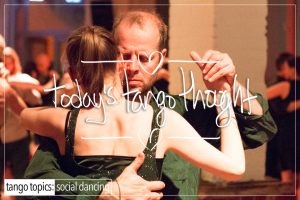Some day soon, you’re going to want the perfect pair of shoes. These shoes in your mind, completes the Tango image you have for yourself dancing socially. They make you look elegant. They make you feel like you can do anything. Mind you that image is an illusion in your head, but let’s not quibble about reality. These shoes are either handmade in Italy, Istanbul, Buenos Aires, or somewhere and/or something in between. They’re the shoes you always dreamed of. They’ve got all the features that you believe will allow you to become, finally, the dancer that you’ve always wanted.
The Reality ? The shoes really don’t matter at all! It’s the skill inside them that matters the most. Work on that, instead of the 200.00 you just spent on a pair of shoes you can’t wear because you haven’t learned how to walk yet!
Put another way, a good number of people (women & men) are sold a bill of goods when they start dancing that they must have ‘the right shoes’ in order to dance, when that’s not the case at all. If you’re learning to dance at a studio, they’re trying to make money by selling you as much stuff as is humanly possible, and you don’t know any better. So the shoe is just one high priced ticket item, that sucks you in and keeps you coming back. The fact is that you need to learn how to walk first and foremost, and that’s not something you’re going to get in 5 minutes (it’s not) but slowly over time, as you retrain your body to do something that is wholly unfamiliar to you. And the shoe, actually, truthfully, honestly gets in the way of that happening for a variety of reasons.
To be fair there is something to be said for comfort and finding the right pair of shoes that do not hurt your feet. However, that is for a later topic.
Do you need shoes right now ? No. Eventually, yes you will…well not really – a pair of socks will do the job just fine until you get your foundation clean/r/ed (that’s the ‘walking’ business above). But eventually you’re going to want to go dancing and not look like a social misfit because you’re in socks, so you’ll want an actual pair of shoes! Honestly though, you really don’t need them, socks or street shoes work just fine, or socks over street shoes. 🙂 However a pair of Comme Il Faut (which had a reputation of being desirable, the company was sold a while back, and the quality isn’t what it used to be – the world has moved on to Madame Pivot actually), or something like that, are just a pair of shoes. To be clear, no matter whom you’ve seen wearing the latest brand of ‘hot shoes’ and the things that those people do in those shoes, it’s not the shoes…it’s the skill set in the shoe – that person! That human being has sweat in front of a mirror for hours, weeks, months, years at a time. Working on refining over and over and over again their ‘technique’. The shoes ? They mean nothing. Don’t miss-hear that as shoe bashing. That shoes aren’t pretty and shouldn’t be worn. No. That is not true. They should be, eventually, but not at the beginning, and certainly not until you have mastered your foundation (which is going to take awhile). Save your pennies (euros, rubles, etc), focus on your technique, focus on practicing (solo practice, and exercises) on a daily basis, focus on actual social dancing. That’s where the real skill lay, not in the shoe. The shoe is an illusion and only an extension of what is inside of you.











